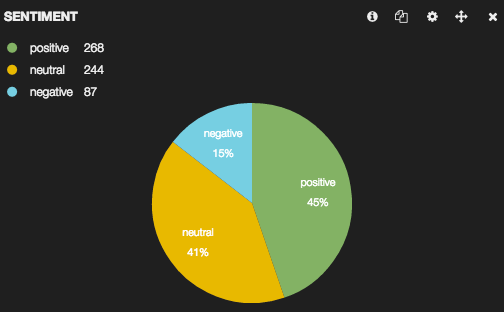Ever wondered whether it's possible to measure your audience's feelings on Twitter by using artificial intelligence tools and techniques? More importantly, is the analysis accurate and useful?
In this blog today, we will address this primary question, paying special attention to what is Twitter sentiment analysis, why it's important, and how you can perform it. Let's jump right in.
What Is Sentiment Analysis?
Also known as opinion mining, sentiment analysis is the process of text mining and using advanced Natural Language Processing (NLP) techniques to analyze the 'sentiment' or feelings of the content and understand whether it's positive, negative, or neutral.
By extension, Twitter sentiment analysis is the analysis of audience tweets, conversations, and opinions to understand how your users feel about your brand. This brings us to the next question:
Why Is There A Need For Sentiment Analysis?
Sentiment analysis is useful for every kind of business. Here are some of its proposed benefits:
- Empowers businesses to monitor brand and product sentiment
- Helps analyze content to pivot business strategy and drive political analysis
- Allows companies to assess audience actions
- Provides real-time insights extracted from customer feedback
- Helps businesses deep-dive into their customer's needs as well as pain-points
Key takeaway: Businesses can make more informed decisions and drive customer satisfaction with the invaluable insights they can gather by engaging in sentiment analysis.
Importance Of Performing Sentiment Analysis On The Twitter Platform
Over 500 million tweets are sent on Twitter every day. In other words, it amounts to 6,000 tweets every second.
To put things into perspective, let's understand why businesses need to leverage the Twitter sentiment analysis dataset. Today, there are over 330 million monthly active users. Imagine the volume of unstructured data and the diversity of conversations the platform demonstrates--from interactions around products and personalities to trending opinions and news information. It's critical that professional entities leverage this treasure trove of information to their benefit. To that end, the advantages of Twitter data analysis trickle down to three main categories:
- Business Strategizing: Twitter sentiment analysis plays a central role in developing a rock-solid business strategy as it can help assess your customers’ feelings towards your product/brand. In fact, data claims that there's been a 2.5x increase in customer service conversations on Twitter over the last two years. The idea is to gauge how your target base is responding to the marketing campaigns and/or product launches, in addition to understanding why some products/campaigns may not be working. Every brand manager and social media manager needs to get their hands on this explosive platform and engage in a Twitter historical search to understand how far the brand has come in the user's mind.
- Politic Sentiment: Unknown to many, a Twitter dataset is also used to monitor political sentiment and orientations towards competing candidates in addition to analyzing election results. This is probably why a staggering 83% of the world’s leaders are active on Twitter. More importantly, research indicates that it can help organizations to download datasets and perform sentiment analysis. This, in turn, can help identify any inconsistencies between government statements and actions and understand a political party's performance while gaining insights into what might work for future elections.
- Public Actions And Opinions: One of the most widespread applications of Twitter sentiment analysis is to gauge brand reputation, determine the sentiment of the Twitterverse, and analyze customer feedback by way of surveys, polls, etc.
Key takeaway: Today's customers are voluntarily vocal on social media platforms and wish to engage with brands, government agencies, and the community at large on a host of topics, ranging from anything and everything. Hence, analyzing the Twitter dataset is no longer a nice-to-have; it has emerged as a necessity.
Four Handpicked Techniques To Perform Twitter Sentiment Analysis
There are various ways to perform Twitter sentiment analysis. However, R and Python are the most widely-used techniques for Twitter data analysis. Let's look at the various techniques to get accurate and on-point data:
Table of Contents
1. Python Libraries
To engage in Twitter data analysis, you'll need to analyze data sentiments using natural language processing. To get started, you can download easy-to-use Python libraries such as Tweepy and TextBlob to analyze the Twitter data and work with code. Tweepy is the python client for the official Twitter API. It allows you to get access to the streaming tweets and filter them as well. Plus, you can access an object and apply any method that the official Twitter API offers. Note that the primary Model classes in the Twitter API include Tweets, Users, Entities, and Places. Upon accessing each class, you'll get in turn a JSON-formatted response. What makes Tweepy easy-to-use is its ability to allow users to navigate through the information seamlessly.
Pro tip: Use pip install <library> to install the relevant libraries.
TextBlob on the other hand helps in processing textual data and assigns polarity values to the tweets. TextBlob stands on the NLTK. You can think of it as the foundational framework for every kind of necessary task that required in basic Natural Language Processing. Remember that TextBlob has advanced features which includes sentiment extraction and spelling correction. In addition to this, you can use TextBlob to:
- Tokenize the text blocks into different sentences and words.
- Extracts nouns and phrases.
- Tag parts of speech with your sentences:

Once you install both, you'll need to authorize the Twitter API client. Next, you'll need to make a GET request to the Twitter API. This will allow you to access tweets for a specific query. Finally, you analyze the tweets and classify them as positive, negative, or neutral.
2. Twitter Sentiment Analysis in R
R is a programming language that's useful for deep statistical analysis. This open source programming language is available across a wide spectrum of platforms (think: Windows, Mac, Linux, etc.)
If you wish to extract and visualize your Twitter data, R is the technique for you. All you need to do is create an app to extract data from Twitter. Here are some prerequisites to keep in mind for creating an app and using R for Twitter data analysis:
- You must install R.
- You should be using RStudio.
- To extract tweets, you'll need a Twitter application and by extension, a Twitter account.
- You'll need your Twitter login ID and password to sign in at Twitter Developers.
- Once your Twitter app is setup, you can access tweets in R.
You can engage in Twitter sentiment analysis in R using the packages, ‘twitteR,' ‘Syuzhet,’ ‘tm,’ and ‘SnowballC’. These will help you to extract tweets from Twitter. Once you've installed the relevant packages, you'll need to invoke the Twitter API using the app to extract data from a particular Twitter handle. The next step would be to clean all the data (think: removing hashtags and URLs). Once the data is cleaned, you can get the sentiment score for each tweet and finally segregate the tweets into positive, neutral, or negative.
3. Elasticsearch Analysis
The Elasticsearch search API allows you to extract basic insights related to a particular field/topic. This method allows you to search and filter Twitter data according to specific areas of interest/topic. You can search on the basis of the text, Twitter username, sentiment search, etc. Once you have a sizeable amount of data at hand, you can use the index ("sentiment") from the sentiment.py script to analyze the data.
4. Kibana Visualiser
This JavaScript-based visual technique allows you to interact with your Twitter data in real-time. It is extremely convenient as you can access it directly from your browser. You can also analyze the Twitter dataset based on location or engage in Twitter hashtags analytics. The Twitter data analysis is visually shown in the form of a pie chart and categorizes the content into three sentiments: positive, neutral, and negative. Here's an example of tweets filtered by the word 'Obama:'

Top-3 Business Applications Of Twitter Sentiment Analysis
1. Social Media Monitoring
Twitter is the hub of everything 'viral'--from memes and videos to comments and trolling, brands need to keep a close eye on the conversations happening on the platform in real-time.
In fact, if your Twitter handle is left unattended, your business will have a PR catastrophe on its hands sooner or later--be it system outages, poor customer service, product bugs, among others. Take the case of United Airlines, which landed in a soup when it deplaned a passenger by 'dragging them off' the plane. What's worse, this incident was captured on video, shared on various platforms such as Twitter, YouTube, etc. and ended up with 6 million-plus views within a span of 24 hours:

This is precisely why brands need to monitor what their customer base, potentials leads, etc., are talking about and how they feel about the brand. This is where Twitter sentiment analysis truly shines. By getting a pulse of how your audience feels in real-time, brands can improve their service and drive brand loyalty.
2. Market Research
Market research and sentiment analysis go hand-in-hand. Whether you wish to anticipate future trends, optimize your marketing budget, or understand how your competition is faring, sentiment analysis can lend a helping hand. You can analyze product reviews, follow your competitors in real-time, analyze industry trends, and identify new and emerging markets using Twitter sentiment analysis.
3. Brand Monitoring
When it comes to whether or not your brand is driving powerful conversations on social media platforms, it's not just about measuring the number of 'brand/product' Twitter mentions. It's important to gauge the 'quality' of these mentions and understand whether Twitter mentions are taking place in a positive, negative, or neutral context. Twitter sentiment analysis allows brands to analyze the overall brand sentiment, categorize their audience, and target them in a personalized and timely capacity.
You can add facebook touch to increase user engagement on facebook platform.
Closing Thoughts: Analyzing Twitter Data Is The Need Of The Hour
Twitter sentiment analysis should be a vital part of every business' digital marketing, customer service, and growth, as well as a branding strategy. If used correctly, it can offer real-time insights and meaningful data into what makes brands 'stick' in the customer's mind, in addition to understanding the audience's pain-points as well as real-time needs. At the end of the day, accurate data can empower teams to work more efficiently and productively, keeping their user's sentiments and feelings at the heart of the business operations.















Leave a Reply